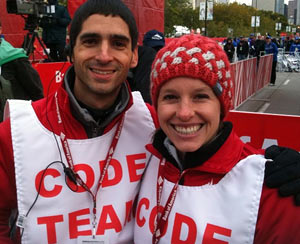Feinberg Personnel Pivotal to Chicago Marathon Medical Safety
|
|
|
Northwestern medical volunteers David Salzman, MD ’05, GME ’09, a fellow in the Feinberg Simulation Technology and Immersive Learning center, and Kelly Williamson, MD, GME ’11, a recent graduate from the Emergency Medicine residency program, at the 2008 Chicago Marathon. |
The Chicago Marathon is the largest sporting event in Chicago. It is the second largest marathon in the world. It raises millions of dollars every year for charities, and provides the city with an economic boom through job creation and tourism.
Such a massive undertaking requires expert medical care, which is why members of Northwestern University Feinberg School of Medicine are using simulation technology to train the marathon’s more than 1,000 medical volunteers. The Simulation Technology and Immersive Learning Center (STIL) created an e-learning training module, the first of its kind within the World Marathon Majors, to help ensure that the physicians, nurses, EMTs, medical students and other health professionals comprising the medical volunteer team are prepared to assist runners on Sunday, October 9.
Lanty O’Connor, Manager of Simulation Technologies for STIL, and Co-director of Medical Education for the Chicago Marathon, explains the two issues medical personnel have faced in the past: “The first problem was that medical volunteers would show up on race day uncertain of their assignment or the logistics. The second was that the medical conditions encountered during the marathon can be quite different from those the volunteers were used to seeing in their day-to-day clinical care.”
According to George Chiampas, DO, Medical Director for the Chicago Marathon since 2007 and an assistant professor in the Feinberg Department of Emergency Medicine, 85 percent of the runners who receive medical attention suffer from exercise-associated collapse. Immediately following a long run, athletes can feel lightheaded and weak in the legs as the body readjusts and blood flow to the heart is briefly interrupted. Treatment consists of elevated legs and rest. Medical volunteers must be able to recognize when a runner is dealing with a more serious condition, and immediately provide the necessary care.
The idea for the training module emerged out of O’Connor’s work with Dr. Chiampas and the Department of Emergency Medicine. Because it was not logistically feasible for the approximately 1,300 medical volunteers to practice simulations on-site at the Feinberg School of Medicine, faculty researched the effectiveness of e-learning modules as an alternative.
The result was a Flash-based PowerPoint program equipped with voiceover narration and interactive graphics that educates healthcare providers on common patient presentations and effective treatments in a marathon setting. Medical volunteers were e-mailed the presentation, which includes a quiz that must be passed to ensure comprehension.
The training was also designed to get volunteers thinking about the teamwork needed for smooth operations. As Dr. Chiampas explains, “The goal is to bring together care providers who do not normally work together and iron out issues like who leads and who handles what. Communication is very important.”
Initial feedback indicates that while volunteers remain a little anxious due to the unique nature of the event, they are “excited about receiving more information prior to the race,” says Dr. Chiampas.
O’Connor will further gauge feedback by speaking to medical volunteers on race day. He also sees potential in developing the program to incorporate analytics that will track and ensure that volunteers are completing the training properly.







